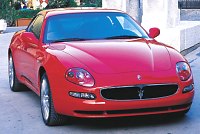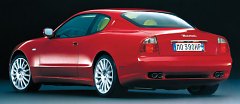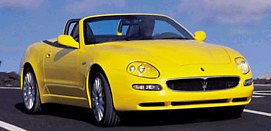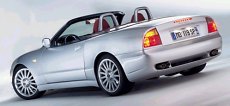 Few
cars arrive like this one: first come Spyder, then come Coupe. Normally
I won’t spend too much words about just another body-style derivative,
but because the Coupe is always more interesting and sensible to me, I
am glad to write another long article. Few
cars arrive like this one: first come Spyder, then come Coupe. Normally
I won’t spend too much words about just another body-style derivative,
but because the Coupe is always more interesting and sensible to me, I
am glad to write another long article.
The original 3200GT was born in 1997. 5 years later comes the 4200GT, which, surprisingly, looks nearly identical. It just receives a small power-dome on the bonnet to accommodate bigger intake manifolds of the V8, and a pair of conventional taillights instead of the original LED lamps. The latter change is said to favour the taste of American, which I cannot agree with. Otherwise the whole body is virtually unchanged, remaining loyal to the Giorgetto Giugiaro design. Improvements on the 4200GT from 3200GT is as vast as its name suggest. In my Spyder report, you have already known about the Ferrari-designed 390 horespower 4.2-litre normally aspirated V8, rear-mounted transaxle layout, paddle-shift sequential 6-speed gearbox and Skyhook adaptive damping. Needless to say, the 4200GT coupe shares all these things with the Spyder. What separate the Coupe from the Spyder are: firstly, of course the metal roof; secondly, 220mm longer wheelbase to accommodate a pair of rear seats (the 4200GT is unchanged from its predecessor, just the Spyder deliberately shortened wheelbase); thirdly, due to the above differences, its body shell is a lot stiffer while front-to-rear weight distribution is improved by 1% to 52:48; ridiculously, at 1680kg, the Coupe is also 50kg lighter than the Spyder, although itself is still 90kg heavier than its predecessor. That’s why I said it is more sensible than the Spyder. In the expense of open air motoring, you get higher performance, better handling as well as 4 real adult seats, the latter is even unique in this class which consists of SL, XKR and 911. The SL does not have any rear seats. The Jag and 911’s are more like dog-seats. In contrast, the Maserati can comfortably accommodate sub-6-footers. Apart from space, the Maserati also beats others by its expensive-feeling, stylish-looking, leather-clad interior. Not even the Mercedes SL can match it, especially for sense of occasion. Italian cars are really special. On the road Thanks to extra stiffness, the coupe chassis is a lot better than the Spyder to drive. Even compare with 3200GT, it has gained 15% in torsional rigidity. This shows in handling and refinement. In the Spyder, the chassis shakes on anything less than smooth surfaces. The Coupe has no such problem. The ride is also more absorbent and quieter, though still far from the league of Mercedes and Jag. There is a "Sport" mode button which controls the intervention level of ASR traction control, the shift speed of Cambiocorsa sequential gearbox and the hardness setting of Mannesman-Sachs Skyhook adaptive damping. With the button depressed, the car rides softly and even floats. A bit more damping could have been better. When "Sport" mode is chosen, its character changes completely. Body control becomes excellent in the expense of comfort. Later intervention of traction controls allow plenty of throttle oversteering to play with.
The paddle-shift sequential gearbox is another weakness. Although in the fastest mode it shifts faster than human hands, shift quality is jerky and brutal. Even in the slowest automatic mode it fails to match the smoothness of real automatic by a large margin. Anyway, the highlight of this Maserati coupe is still the wonderful Ferrari V8. Unquestionably, this is the world’s best performance V8 currently on offer, beating BMW’s 5.0 V8 and Ferrari’s own 3.6 V8. Better than the BMW M5 engine is because it is so high-revving, capable of spinning cleanly to 7750rpm. Better than the Ferrari 360 Modena engine is because it is so smooth, thanks to the cross-crank design. This is the only V8 offering high specific output (92hp/litre), revability, linearity, low-speed tractability, smoothness and beautiful growl simultaneously. Well done Maranello! The 4200GT cuts 0.2 seconds from Spyder for 0-60mph acceleration. Maserati claims an unbelievable 4.6 seconds and a top speed of 177mph. Autocar managed just 4.9 seconds. The Spyder has
never caught
my heart. The Coupe, though still imperfect, is a much better car.
While
objectively it fails to trouble Mercedes SL, its unique character may
catch
the heart of many car lovers. |
| The above report was last updated on 26 May 2002. All Rights Reserved. |
 However,
the steering still let us down and devoid of an otherwise fun driving
experience.
Although it does not have road-sensitive kickback like the Spyder, it
is
lack of feel on straight ahead and turn-in is not as sharp as it should
have been. Look at the spec. and you will know - the steering rack
takes
a full 3.0 turns from lock to lock. At high speed, the steering is also
too light to inspire confidence.
However,
the steering still let us down and devoid of an otherwise fun driving
experience.
Although it does not have road-sensitive kickback like the Spyder, it
is
lack of feel on straight ahead and turn-in is not as sharp as it should
have been. Look at the spec. and you will know - the steering rack
takes
a full 3.0 turns from lock to lock. At high speed, the steering is also
too light to inspire confidence.  4
years ago, Ferrari took over the control of Maserati from Fiat and De
Tomaso.
However, the first 100% Ferrari-developed Maserati did not come until
the
new Spyder. The 3200GT is almost a Maranello job, but it is still
powered
by a 3.2-litre twin-turbo V8 originated from the Shamal of a decade
ago.
Now Ferrari finally gets rid of the last link with the old era,
introduces
a normally aspirated V8 in the Spyder. If you remember, Maserati have
long
forgotten normally aspirated engines since Biturbo appeared in 1980.
Although
Bi-turbo engines never disappointed, their images were linked with the
darkest 2 decades during which poor quality and flawed engineering were
notorious. Now with a Ferrari V8, hopefully the Spyder will inject a
new
lease of life into Maserati. The coupe 3200GT will follow later.
4
years ago, Ferrari took over the control of Maserati from Fiat and De
Tomaso.
However, the first 100% Ferrari-developed Maserati did not come until
the
new Spyder. The 3200GT is almost a Maranello job, but it is still
powered
by a 3.2-litre twin-turbo V8 originated from the Shamal of a decade
ago.
Now Ferrari finally gets rid of the last link with the old era,
introduces
a normally aspirated V8 in the Spyder. If you remember, Maserati have
long
forgotten normally aspirated engines since Biturbo appeared in 1980.
Although
Bi-turbo engines never disappointed, their images were linked with the
darkest 2 decades during which poor quality and flawed engineering were
notorious. Now with a Ferrari V8, hopefully the Spyder will inject a
new
lease of life into Maserati. The coupe 3200GT will follow later.
 Now
you can see the conversion from Coupe to Spyder is a thorough
re-engineering
rather than a roof job or engine job. The metal roof is of course
discarded,
but so are the rear seats and 220mm wheelbase. Maserati shortened the
car
in order to compensate for the loss of chassis strength in the
cabriolet
conversion. A pair of roll-protection bars is also added behind the
headrests
as an integral part of chassis reinforcement. In addition to the
electric
soft roof and some equipment upgrade, you will find the Spyder weighs
1730kg,
140kg heavier than the coupe. So Maranello didn’t work hard on weight
saving.
Now
you can see the conversion from Coupe to Spyder is a thorough
re-engineering
rather than a roof job or engine job. The metal roof is of course
discarded,
but so are the rear seats and 220mm wheelbase. Maserati shortened the
car
in order to compensate for the loss of chassis strength in the
cabriolet
conversion. A pair of roll-protection bars is also added behind the
headrests
as an integral part of chassis reinforcement. In addition to the
electric
soft roof and some equipment upgrade, you will find the Spyder weighs
1730kg,
140kg heavier than the coupe. So Maranello didn’t work hard on weight
saving.  The
cabin preserves tasteful styling and full leather packaging. Fit and
finish
is excellent although some plastics and switches in center console are
not high quality. However, compare with Porsche and Jaguar the Maserati
cabin feels more expensive and exclusive. It just loses ground in space
- legroom is quite tight and the driver sit too close to windscreen
pillar.
Maserati could have shortened the wheelbase a few inches less to
benefit
cabin room. I don't understand why it did not do so. General refinement
of the roof and air-flow management is effective, if not remarkable.
The
cabin preserves tasteful styling and full leather packaging. Fit and
finish
is excellent although some plastics and switches in center console are
not high quality. However, compare with Porsche and Jaguar the Maserati
cabin feels more expensive and exclusive. It just loses ground in space
- legroom is quite tight and the driver sit too close to windscreen
pillar.
Maserati could have shortened the wheelbase a few inches less to
benefit
cabin room. I don't understand why it did not do so. General refinement
of the roof and air-flow management is effective, if not remarkable.